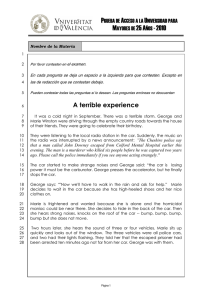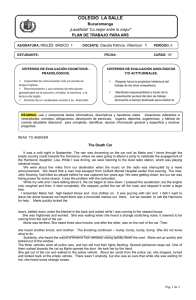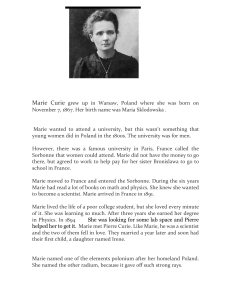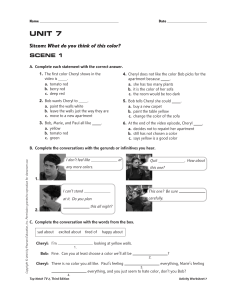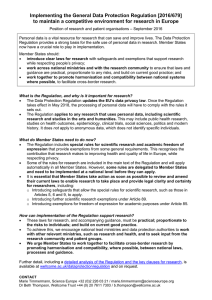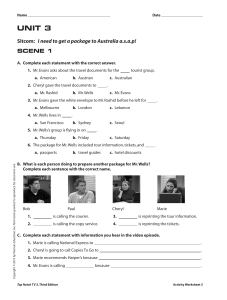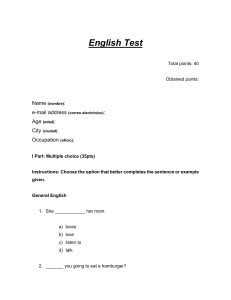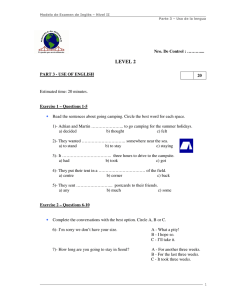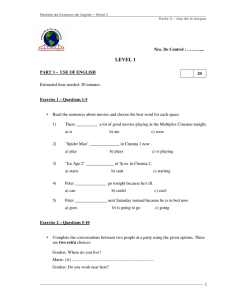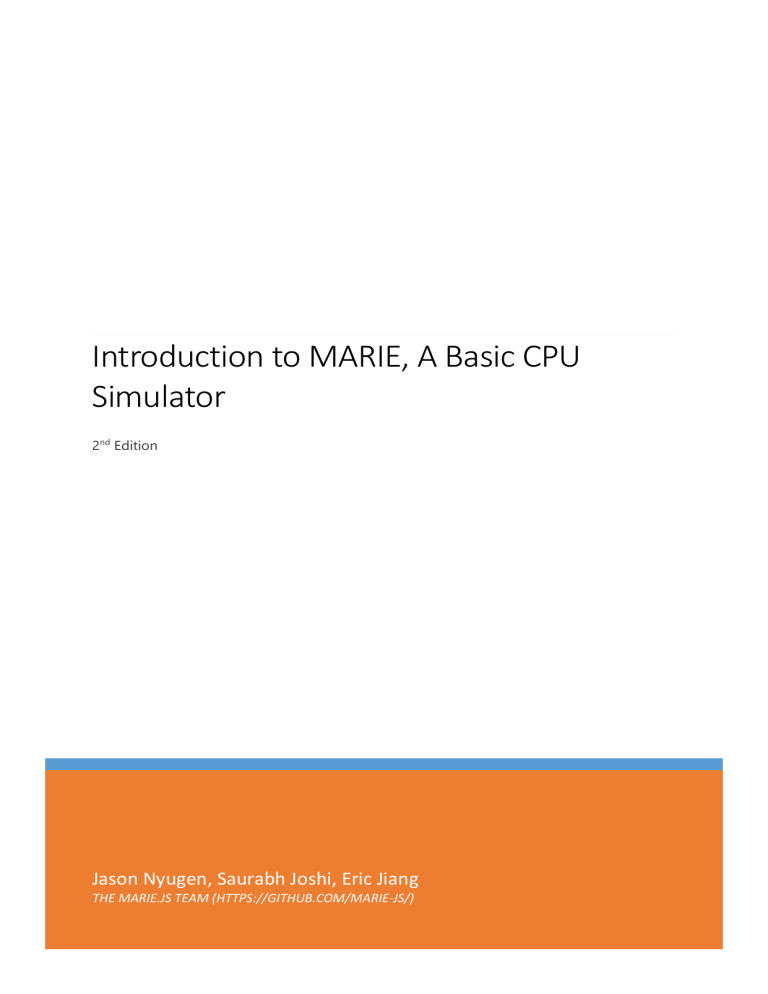
Introduction to MARIE, A Basic CPU
Simulator
2nd Edition
Jason Nyugen, Saurabh Joshi, Eric Jiang
THE MARIE.JS TEAM (HTTPS://GITHUB.COM/MARIE-JS/)
Introduction to MARIE, A Basic CPU Simulator
Copyright © 2016
Second Edition Updated August 2016
First Edition – July 2016
By Jason Nyugen, Saurabh Joshi and Eric Jiang
This document is licensed under the MIT License
To contribute to our project visit: https//www.github.com/MARIE-js/MARIE.js/
The MIT License (MIT)
Copyright (c) 2016 Jason Nguyen, Saurabh Joshi, Eric Jiang
Permission is hereby granted, free of charge, to any person obtaining a copy of this software and associated documentation
files (the "Software"), to deal in the Software without restriction, including without limitation the rights to use, copy, modify,
merge, publish, distribute, sublicense, and/or sell copies of the Software, and to permit persons to whom the Software is
furnished to do so, subject to the following conditions:
The above copyright notice and this permission notice shall be included in all copies or substantial portions of the Software.
THE SOFTWARE IS PROVIDED "AS IS", WITHOUT WARRANTY OF ANY KIND, EXPRESS OR IMPLIED, INCLUDING BUT NOT
LIMITED TO THE WARRANTIES OF MERCHANTABILITY, FITNESS FOR A PARTICULAR PURPOSE AND NONINFRINGEMENT. IN
NO EVENT SHALL THE AUTHORS OR COPYRIGHT HOLDERS BE LIABLE FOR ANY CLAIM, DAMAGES OR OTHER LIABILITY,
WHETHER IN AN ACTION OF CONTRACT, TORT OR OTHERWISE, ARISING FROM, OUT OF OR IN CONNECTION WITH THE
SOFTWARE OR THE USE OR OTHER DEALINGS IN THE SOFTWARE.
Please reference this document at https://marie-js.github.io/MARIE.js/book.pdf for Student Integrity Policies for more
information please visit your university’s Student Integrity Policy.
Introduction to MARIE, A Basic CPU Simulator
Contents
Introduction to MARIE and MARIE.js ................................................................................................................ 2
MARIE Instruction Set............................................................................................................................................. 4
Register Transfer Language ................................................................................................................................. 6
Introduction ........................................................................................................................................................... 6
RTL of Basic MARIE Code ................................................................................................................................. 6
Direct Addressing ........................................................................................................................................... 6
Store X................................................................................................................................................................. 6
Add X ................................................................................................................................................................... 7
Subt X .................................................................................................................................................................. 7
Jump X ................................................................................................................................................................ 7
Indirect Addressing ............................................................................................................................................. 7
LoadI X ................................................................................................................................................................ 7
JnS X..................................................................................................................................................................... 7
JumpI X ............................................................................................................................................................... 8
Datapath Simulator ................................................................................................................................................. 9
Register bank ..................................................................................................................................................... 11
Memory ................................................................................................................................................................ 12
Read control bus............................................................................................................................................... 12
Write control bus .............................................................................................................................................. 13
Data bus ............................................................................................................................................................... 13
Address bus ........................................................................................................................................................ 14
Decode bus ......................................................................................................................................................... 14
The control unit, and putting it all together .......................................................................................... 14
Tutorials .................................................................................................................................................................... 15
A Simple Calculator ......................................................................................................................................... 15
Concepts.......................................................................................................................................................... 15
Coding.............................................................................................................................................................. 15
Multiplication in MARIE.................................................................................................................................. 17
Explanation ..................................................................................................................................................... 17
Writing the Code .............................................................................................................................................. 17
Full Code .............................................................................................................................................................. 19
Nyugen, Joshi and Jiang
Page 1 of 20
Introduction to MARIE, A Basic CPU Simulator
Introduction to MARIE and MARIE.js
MARIE ('Machine Architecture that is Really Intuitive and Easy') is a machine architecture and
assembly language served only for educational purposes from The Essentials of Computer
Organization and Architecture (Linda Null, Julia Lobur). In addition, the publisher provides a
set of simulator programs for the machine, written in Java. MARIE.js is a JavaScript version
implementation of MARIE. It aims to be as faithful to the original Java programs as it can,
while improving on features to make concepts more intuitive and easier to understand. In
this book we will use MARIE.js this is available at: https://marie-js.github.io/MARIE.js/ The
basic idea, is that the MARIE assembly language is a simple implementation of the von
Neumann architecture as shown below.
An assembly language is the lowest level of abstraction you can get away from machine
language, which is binary code. Each instruction corresponds to its binary representation.
There are several assembly languages, one for each machine architecture. More familiar
architectures like x86, ARM and MIPS are fairly complicated (x86 even more so than ARM and
MIPS),
which is why MARIE is designed to be easy to understand (hence its name).
Nyugen, Joshi and Jiang
Page 2 of 20
Introduction to MARIE, A Basic CPU Simulator
So in MARIE (as well as in other architectures) we have a collection of registers. These
registers are shown below:
AC or Accumulator intermediate data is stored within the AC
PC or Program Counter as the name suggests it stores the current position of the
instruction, with each instruction having its own address
MAR or Memory Access Register stores or fetches the 'data' at the given address
MBR or Memory Buffer Register stores the data when being transferred to or from
memory
IR or Instruction Register: holds the current instruction
Nyugen, Joshi and Jiang
Page 3 of 20
Introduction to MARIE, A Basic CPU Simulator
MARIE Instruction Set
In MARIE, each instruction is 16 bits long with the first 4 bits representing the opcode and the remaining 12 bits are being used to
represent the address.
For example the instruction CLEAR, the Opcode is A in HEX and 1010 in binary so the instruction will look something like
1010.............
Type
Arithmetic
Data Transfer
I/O
Instruction
Hex
Summary
Opcode
Add X
3
Adds value in AC at address X into AC, AC ← AC + X
Subt X
4
Subtracts value in AC at address X into AC, AC ← AC - X
AddI X
B
Clear
A
AC ← 0
Load X
1
Loads Contents of Address X into AC
Store X
2
Stores Contents of AC into Address X
Input
5
Request user to input a value
Output
6
Prints value from AC
Nyugen, Joshi and Jiang
Add Indirect: Use the value at X as the actual address of the data operand to add to
AC
Page 4 of 20
Introduction to MARIE, A Basic CPU Simulator
Jump X
Branch
9
Jumps to Address X
Skips the next instruction based on C: if (C) is
Skipcond (C)
8
- 000: Skips if AC < 0
- 400: Skips if AC = 0
- 800: Skips if AC > 0
Subroutine
JnS X
0
Jumps and Store: Stores PC at address X and jumps to X+1
JumpI X
C
Uses the value at X as the address to jump to
Stores value in AC at the indirect address.
StoreI
E
e.g. StoreI addresspointer
Indirect
Gets value from addresspointer, stores the AC value into the address
Addressing
Loads value from indirect address into AC
LoadI
D
e.g. LoadI addresspointer
Gets address value from addresspointer, loads value at the address into AC
Halt
Nyugen, Joshi and Jiang
7
End the program
Page 5 of 20
Introduction to MARIE, A Basic CPU Simulator
Register Transfer Language
Introduction
Register Transfer Language or RTL shows how the CPU (Assembler) works. Within the CPU
there are many components including:
AC or Accumulator : intermediate data is stored within the AC
PC or Program Counter : as the name suggests it counts the current position of the
code, each line has it's own address
MAR or Memory Access Register , stores or fetches the 'data' at the given address
MBR or Memory Buffer Register , stores the data when being transferred
IR or Instruction Register
Note that the end of each code, you will need to increment the PC by 1, so:
PC ← PC + 1
RTL of Basic MARIE Code
Direct Addressing
Load X
As explained earlier Load X loads the value from address X into the AC
MAR ← X
MBR ← M[MAR]
AC ← MBR
# load X (address) into MAR
# load value stored at address into MBR
# load value in MBR into AC
Store X
Store X stores the current value from the AC into address X
MAR
← X
MBR
← AC
M[MAR] ← MBR
# load address into MAR
# load AC value into MBR
# writes MBR value into the Memory of address indicated by the MAR
Nyugen, Joshi and Jiang
Page 6 of 20
Introduction to MARIE, A Basic CPU Simulator
Add X
Add X adds the value stored at address X into AC
MAR ← X
MBR ← M[MAR]
AC ← AC + MBR
# load X into MAR
# load value stored at address X into MBR
# add value in AC with MBR value and store it back into AC
Subt X
Subt X subtracts the value in AC with the value stored at address X
MAR ← X
MBR ← M[MAR]
AC ← AC - MBR
Jump X
Jump X jumps to address X
PC ← X
Indirect Addressing
LoadI X
LoadI X loads the value which is stored at address of the address X into the AC
MAR
MBR
MAR
MBR
AC
←
←
←
←
←
X
M[MAR]
MBR
M[MAR]
MBR
#
#
#
#
#
load
load
load
load
Load
value
value
value
value
value
X into MAR
stored at address X into MBR
back into MAR (MAR cant write itself)
into MBR stored at the address indicate by MAR
into AC.
JnS X
JnS X or Jumps and Stores: Stores PC at address X and jumps to X+1
MAR
MBR
M[MAR]
AC
PC
←
←
←
←
←
X
PC + 1
MBR
X + 1
AC
Nyugen, Joshi and Jiang
#
#
#
#
#
loads value X into MAR
loads value of PC into MBR
stores value in MBR into address of MAR
increments X by 1 and stores it into AC
jumps program counter to address indicated by AC
Page 7 of 20
Introduction to MARIE, A Basic CPU Simulator
JumpI X
JumpI X uses the value at X as the address to jump to
MAR
MBR
MAR
MBR
PC
←
←
←
←
←
X
M[MAR]
MBR
M[MAR]
MBR
Nyugen, Joshi and Jiang
#
#
#
#
#
loads value X into MAR
loads value stored at address X into MBR
loads value back into MAR
fetches the value at the address into MBR
loads the value into PC
Page 8 of 20
Introduction to MARIE, A Basic CPU Simulator
Subroutines
Subroutines
A subroutine is a sequence of instructions that is modular and can be executed multiple
times. If you are familiar with any programming language, you may see that subroutines are
similar to functions. If you only dealt with functions in mathematics, you could view
subroutines in terms of inputs and outputs. However the way they perform operations can
be quite different. Furthermore, MARIE doesn't provide a way to specify input or output
values (for programmers, parameter or return values).
MARIE provides a way to call these subroutines by using the JnS instruction, and normal
program execution can be resumed once the subroutine exits by using the JumpI instruction.
Example
Here is an example that prints the variable X, then halts the program:
/ Enter subroutine PrintVariableX
JnS PrintVariableX
Halt
PrintVariableX, HEX 000 / Used for storing return address
Load X
Output
/ Exit subroutine PrintVariableX
JumpI PrintVariableX
X, DEC 42
The JnS instruction stores the address of the next instruction after it was called. In this case,
the memory address points to the Halt instruction. This is the return address which will be
later used to restore program execution. Once it has done that, it then jumps to the
instruction immediately below the label PrintVariableX, by using the memory address
of PrintVariableX and incrementing that value once.
Once the subroutine performs its intended task, and runs the JumpI instruction, it loads the
memory address stored at the PrintVariableX label, and stores it into the PC register. Note that
we don't need to increment the PC register here as it is already taken care of in the fetch part
of the fetch-decode-execute cycle before it entered the subroutine. Program execution is
resumed from where it was, and the program halts as the Halt instruction is executed.
The major part of subroutines is that it can be reused. Here is a slightly modified example
that illustrates this.
Nyugen, Joshi and Jiang
Page 9 of 20
Introduction to MARIE, A Basic CPU Simulator
/ Call subroutine PrintVariableX
JnS PrintVariableX
Load X
Add Y
Store X
JnS PrintVariableX / Call subroutine PrintVariableX again
Halt
PrintVariableX, HEX 000 / Used for storing return address
Load X
Output
/ Exit subroutine PrintVariableX
JumpI PrintVariableX
X, DEC 42
Y, DEC 5
It doesn't matter where you call the subroutines (unless the subroutine calls itself), or how
many calls you make to the subroutines. The return address will be overwritten, and program
execution will always be resumed to where it was once the subroutine exits.
Nyugen, Joshi and Jiang
Page 10 of 20
Introduction to MARIE, A Basic CPU Simulator
Datapath Simulator
The datapath simulator is incorporated into MARIE.js, and can be accessed via the
menu: View → Datapath.
The purpose of this visualisation is to give an understanding of how instructions and microinstructions relate to sequence of physical signals.
Register bank
The MARIE simulator register bank is a set of 7 registers used for different purposes. For
example, the PC register holds the memory address that points to the next instruction.
Here is a list of the registers used in the MARIE simulator.
Name
Opcode
Abbreviation
# of bits stored
Memory Address Register
001
MAR
12
Program Counter
010
PC
12
Memory Buffer Register
011
MBR
16
Accumulator
100
AC
16
Input
101
IN
16
Output
110
OUT
16
Instruction Register
111
IR
16
Nyugen, Joshi and Jiang
Page 11 of 20
Introduction to MARIE, A Basic CPU Simulator
Memory
The memory stores data in a sequence of locations. At this point of time, nothing much is
shown in the memory, apart from whether data is being read from or written to memory.
It is important to know that the data in each memory cell has no meaning in itself. For
example, a memory cell may represent as data 0000 (which is very common as usually most
of memory cells are empty), but can also be seen as a JnS instruction with memory
address 000, as the highest hexadecimal value is the same as the opcode for the JnS
instruction.
Read control bus
The read control bus tells which register (or memory) to output data into the data bus.
Abbreviation
Opcode
Activate Wires
M[MAR]
000*
Mr
MAR
001
P0
PC
010
P1
MBR
011
P1 P0
AC
100
P2
IN
101
P2 P0
OUT
110
P2 P1
IR
111
P2 P1 P0
* While the memory opcode is 000, it technically means that we do not want to access any
register. This is the reason why we have a separate memory read wire so that we can tell the
memory exactly when we want to fetch the contents of one memory cell.
Nyugen, Joshi and Jiang
Page 12 of 20
Introduction to MARIE, A Basic CPU Simulator
Write control bus
The write control bus tells which register (or memory) to read from the data bus and
override its value.
Abbreviation
Opcode
Activate Wires
M[MAR]
000*
Mw
MAR
001
P3
PC
010
P4
MBR
011
P4 P3
AC
100
P5
IN
101
P5 P3
OUT
110
P5 P4
IR
111
P5 P4 P3
* Like what is said previously in the read control bus section, this opcode just means do not
write to any register. A separate memory write wire is activated instead when we need to
write to memory
Data bus
The data bus is 16 bits long, and is used for transferring data (which may hold memory
addresses) between registers and/or the memory. It is connected to all registers as well as
the memory.
Nyugen, Joshi and Jiang
Page 13 of 20
Introduction to MARIE, A Basic CPU Simulator
Address bus
The address bus is 12-bits long, and is connected to both the MAR register and the memory.
Decode bus
The "decode bus" is 4-bits long, and is connected to both the IR register and the control
unit. Only the highest 4 bits of the IR register is connected to the decode bus, which is used
as input for decoding which instruction is needed to be executed.
The control unit, and putting it all
together
The control unit handles both the register bank, the memory, and the ALU. It does this by
generating a sequence of signals, depending on what instruction it has decoded. All
instructions begin with the fetch cycle, which the control unit fetches the next instruction
from memory, and increments the program counter. Once the instruction is decoded, it
executes the instruction by performing the corresponding sequence of RTL operations. Each
RTL operation has its own set of signals that needs to be generated.
The active 'LED' in the time sequence signal labelled Tn where n is an unsigned integer, shows
how many RTL operations have been performed before the current one within the current
instruction. These sequential signals are reset once the control unit has finished executing
the current instruction and is ready to execute the next instruction.
The first three (T0, T1, T2) time sequence signals are dedicated to the fetch part of the fetchdecode-execute cycle. The rest of the time sequence depends on what instruction the
control unit has decoded from the IR.
Nyugen, Joshi and Jiang
Page 14 of 20
Introduction to MARIE, A Basic CPU Simulator
Tutorials
A Simple Calculator
In this tutorial we are going to write some code which assembles a simple addition
calculator.
Concepts
Variables in MARIE are in string, for example both the variables X and value work in MARIE.
Variables are typically declared at the bottom of the code.
The instruction INPUT takes a user input and loads it into the Accumulator or AC
Coding
The main idea is to get the user to input two values and store it into two variables: X and Y. A
simple way to do this is:
INPUT
Store X
INPUT
Store Y
This will store the user input into two variables: X and Y. For the purposes we recommend
you set the input and output value types to DEC (Decimal) mode. The next part requires us
to Load X into the AC, then Add Y, output it then Halt the program.
Load X
Add Y
Output
Halt
Now, declare these variables into 'temporary' values, note that declaration is usually at the
end of the code.
X, DEC 0
Y, DEC 0
Nyugen, Joshi and Jiang
Page 15 of 20
Introduction to MARIE, A Basic CPU Simulator
There we have it. The code should something like
INPUT
Store X
INPUT
Store Y
Load X
Add Y
Output
Halt
X, DEC 0
Y, DEC 0
Nyugen, Joshi and Jiang
Page 16 of 20
Introduction to MARIE, A Basic CPU Simulator
Multiplication in MARIE
The goal of this section is for you to write some code for multiplying two integers
together, especially negative integers. This page explains how to multiply integers that
are both non-negative.
Since we can only add and subtract in MARIE, there is no multiply command in
MARIE. Instead we can use a combination of Add and Subt instructions to perform
iterative addition and terminate the program once it computes the result.
Explanation
Iterative addition is the simplest method for performing multiplication on integers.
For example, the expression 3*4 can be expressed as 3 added to itself 4 times:
i.e. 3+3+3+3. As multiplication is commutative (i.e. order of multiplying numbers does
not matter), this is also the same as 4 is added to itself 3 times: 4+4+4.
Selection statements
There are no if or else statements in MARIE, as implementing them is a bit
complicated and would require several instructions. Instead we use Skipcond. Skipcond
(num) skips the next line if a certain condition is true (which is explained in the MARIE
Instruction Set Section).
Writing the Code
So what we need for the expression X*Y are two variables, X and Y.
What we can do is to allow the user to input integers into the two variables like so:
INPUT
Store X
INPUT
Store Y
Nyugen, Joshi and Jiang
Page 17 of 20
Introduction to MARIE, A Basic CPU Simulator
The idea is we are going to add X, Y Times. For this code, we need to load the
variable num into the accumulator, then adds X to it and stores it back into the
variable num. Then it loads Y into the accumulator and subtracts 1 from it and stores it
back into Y. Then it uses the Skipcond 400statement to check if Y is equal to 0. If it is it
will 'Jump' over the Jump loop command and loads the number and outputs the result
before halting. Now we are going to look at the main loop - this is because we need
to check when Y is equal to 0. So the main loop will look something like:
loop,
Load num
Add X
Store num
Load Y
Subt one
Store Y
Skipcond 400
Jump loop
Load num
Output
Halt
Now, we need to declare the variables. So:
X, DEC 0
Y, DEC 0
one, DEC 1
num, DEC 0
Nyugen, Joshi and Jiang
Page 18 of 20
Introduction to MARIE, A Basic CPU Simulator
Full Code
/ Prompt user to type in integers
INPUT
Store X
INPUT
Store Y
/ Loop for performing iterative addition
loop,
Load num
Add X
Store num
Load Y
Subt one
Store Y
Skipcond 400 / have we completed the multiplication?
Jump loop / no; repeat loop
/ yes, so exit the loop
/ Output result to user then halt program
Load num
Output
Halt
/ Declare labels here
X, DEC 0
Y, DEC 0
one, DEC 1
num, DEC 0
Nyugen, Joshi and Jiang
Page 19 of 20
